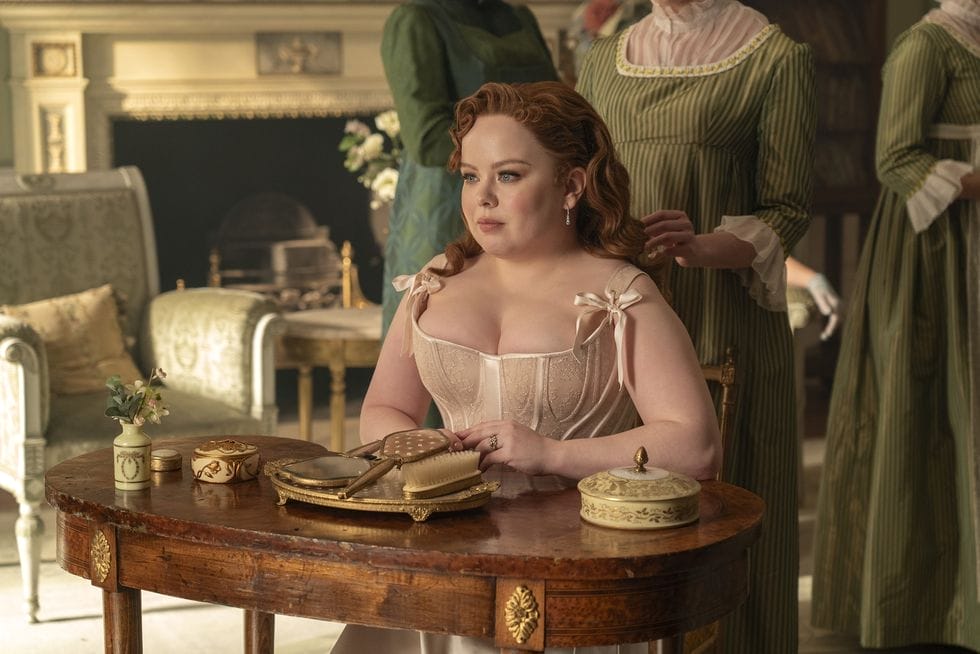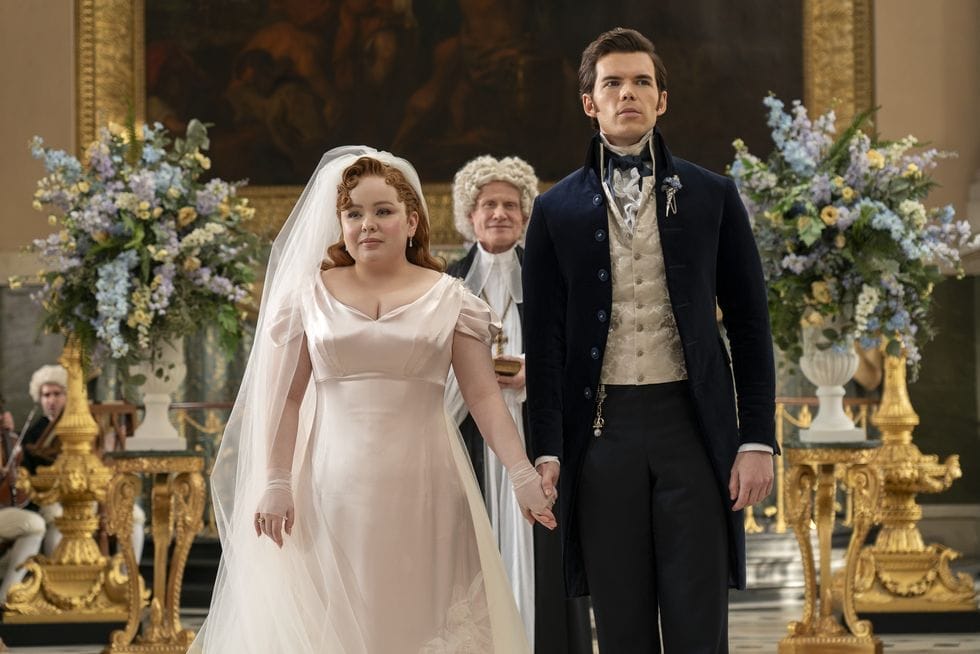
NETFLIX
Words By Todd Plummer
Plus, why Penelope Featherington wore a pink gown for her big day
Of course there’s a wedding this season. It’s Bridgerton—why wouldn’t there be? But ye be warned, fair reader, there are spoilers ahead here.
There are so many fashion moments to love in the third season of Netflix’s period romance—the second half of which is out today—but the one that left us breathless beyond all the others was in fact our beloved Penelope’s wedding dress: For her trip down the aisle, Miss Featherington eschews tradition, opting for a simple blush-pink dress. Produced by Shonda Rhimes, the show has delivered anachronistic, fanciful takes on “Regency fashion” (and we’re using that term loosely) since its first season, so it should come as no surprise that the wedding of a major character would be no less fantastic.
Bazaar caught up with costume designer John Glaser—who worked on season one, skipped season two, and returned for season three—about bringing the Bridgerton universe to life through its clothing.

NETFLIX
You worked on season one, did not work on season two, and you then came back for season three. How has the show changed?
Season one was really much more like a pilot to see where we were going, and we were all unsure. Now, for season three, we actually know the characters, the story, and we can be a very good judge to put our own spin on it. One thing that was interesting in taking a season off was that the story has matured and the actors have matured, both physically and mentally. They were really young when they started, and now they’ve been through the mill, so it was a little different feeling.
Do you think Bridgerton has changed the way audiences see period productions?
I think it has allowed other productions to have a little more freedom in doing pieces, because people now accept that in fact what we see onscreen doesn’t have to be historically accurate. … We’ve taken current influences and historical influences and mixed it all up into one big pot. For the most part, my costume designing career was about re-creating history, whereas this was pure design. I previously worked on a show called The Knick, which took place in 1900, and we did the same thing—we stylized the costumes so it was period, but had a modern feel to it. And we also did that for another Shonda Rhimes show called Still Star-Crossed. Here, the only thing we were told was that there would be no bonnets.

NETFLIX
What do you have against bonnets?!
There are no hats on women in Bridgerton! We use a few on men only, but if an actor has good hair and a good face, there’s no hat. It’s all about beauty.
Let’s talk about Penelope Featherington’s wedding. She wears a very memorable, relatively simple blush dress. Why did you make that choice?
It was pretty simple: We didn’t want a white dress because it’s too conventional. It also isn’t even correct for that period. A lot of people today expect to see a white dress, but if we had put a white dress on Penelope, she would have looked like a nurse. We actually started off with a pale, pale ice blue, because she was marrying a Bridgerton, but it didn’t work with her skin tone. What we tried to do was have her clothing be in much softer colors because we didn’t want to detract from her character or styling. So that’s why we thought, Let’s make a simple wedding dress that doesn’t distract from the ceremony. We wanted to enhance her figure, and create something beautiful without pulling focus. I was thinking about all these classic beauties, and Lauren Bacall is an example—you remember what these people look like, but you don’t necessarily remember what they’re wearing.
I know some people wanted to see some extravagant gown, but we didn’t want to distract. Penelope had to go to the after-party and had to dance in it. We wanted it to be a little unexpected. And also by this point in the show, Penelope is an experienced woman who has nothing to prove except to herself.

NETFLIX
There’s such an interesting use of color in that wedding sequence. It’s been a recurring conceit in the Bridgerton universe that the different families each have their own color-coding.
We did the Bridgerton boys in navy blue velvet and Tiffany blue, and the other side was the Featheringtons with greens and citrus colors. We used no blush anywhere else in that scene, so that made Penelope’s dress feel stronger without having to do anything.
Do you think Bridgerton has had an impact on contemporary fashion?
Our job is not to influence fashion, or we really don’t think about that. Our job is to help tell the story. If it does influence it, I would not be surprised, but that’s not our intention. But it might!
What was the most challenging look to get right this season?
Nothing really stands out. Everything was an enjoyable challenge. But I’ll say one thing that was difficult generally: not giving too much, and we needed to restrain ourselves from going too far. In the case of Cressida [Cowper, played by Jessica Madsen], where we’ve gone so far on the extreme with her silhouette, that’s because we thought that fashion is her armor, so we made it as big and strong as possible. The difficulty for us is that we’ve been given so much freedom from Shondaland that we need to restrain ourselves from going too far.
Cressida has a pair of gold sleeves that are really big, for the Innovation Ball. But we did get one note from the producer that in post-production, the editors had problems because Cressida’s sleeves filled the screen, and it seemed like Eloise was speaking to Cressida’s sleeves and not her face.

NETFLIX
I’ve had this theory since Poor Things and Taylor Swift’s “Fortnight” video that leg-of-mutton sleeves are about to have a big moment.
The interesting thing is that our assistant costume designer George Sayer was also the assistant costume designer on Poor Things. So those big sleeves traveled naturally with George to this show. A chicken-and-the-egg situation!
This article originally appeared in harpersbazaar.com



